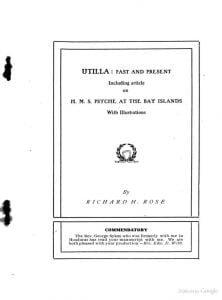The picturesque island of Utilla is the most south-westerly of the group known as the Bay Islands. The islands are six in number. They are Ruatan, Bonacco, Utilla, Helene, Barburat and Morat; and are situated in the Bay of Honduras an arm of the Caribbean Sea. Bonacco, the most easterly of the group, was discovered by Columbus on his fourth voyage in 1502. Taken together these islands form a flourishing Department in the Republic of Honduras.
In 1858 the population of Utilla was 101 souls. It now (1904) numbers nearly 800 inhabitants. And for many years past the island has been a theater of action, in a small way, through the efforts and energies of its thrifty people who arc striving and aspiring toward a higher state of existence.
Utilla is rich in fanciful names. Some one not very long ago christened it “A Lazy Man’s Paradise.” It seems that some people’s idea or vision of earthly bliss is to be in a place where one may live a dreamy and inactive life only smoking a pipe and swinging in a hammock and so be as happy as the day is long. And this beatific condition, it is thought by the dreamers, can be realized only in some delightful spot in the tropics. Nature is truly very generous in these parts, and the fertile soil frequently rewards the planter by yielding the full “hundred fold.” Nevertheless here as elsewhere the law remains fixed: “In the sweat of thy face,” and the rest.
Historians have informed us that the Bay Islands were thickly populated at the time of their discovery. And on this island, (Utilla), there are ample proofs of the truth of these statements.
Senor Antonio R. Vallejo has written a most interesting treatise on the Bay Island’s, sketching their history to within a few years ago. In writing of the native Indians he says among other things, that “the Queen of Spain granted an order conceding license to whoever could capture the islanders and sell them. In 1516 Diego Velasquez, Governor of Cuba, authorized several Spaniards to form companies for the purpose of carrying on the slave trade, making slaves of the natives.”
“Several historians,” continues Mr. Vallejo, “affirm that, thus authorized, seventy Spaniards sailed from the port of Santiago de Cuba in a ship and a brigantine for the Bay Island’s.” On this and subsequent voyages hundreds of the defenseless aborigines were captured and carried in slavery to Cuba. “Moreover a powerful party of filibusters occupied the islands in the early part of 1642. They enslaved the remaining Indians until in March 1650 the former were dislodged from the islands by a strong expedition of Spanish warships. The Captain General of Guatemala then transferred the few remaining Indians to the continent near by the river Motagua.” Thus these once populous islands were depopulated, and remained so for a considerable period.
Table of Contents
- Introductory
- The Early Settlers
- British Colonization and Cession
- Indian Relics
- A Glance at Honduras
- East Harbor — The Cays
- Homicides
- Religion — Exciting Tent Meetings
- Utilla Fusiladed
- Presidents Visit the Island
- The Banana Business
- Boating
- Smallpox at The Cays
- General Items
- Aunt Betsy
- Mrs. Gabourels
- The Woodvilles
- Frightful Accident Causing the Death of Mr. Loomis
- Encounter with Alligator
- Dancing
- Burnt to Death
- British Naval Officers at Grave, etc.
- H. M. S. Psyche at the Bay Islands
- Concluding Remarks

[box]Rose, Richard H. Utilla Past and Present: Including Article on H.M.S. Psyche at the Bay Islands, with Illustrations. Dansville, NY: F. A. Owen Publishing Co. 1904.[/box]
